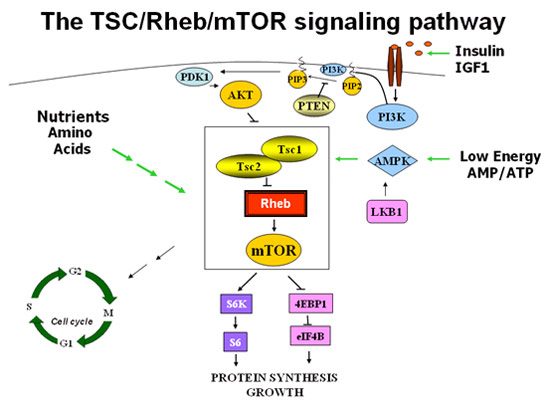- Mechanism of TSC Regulation of Neuronal Differentiation
- The Importance of Rheb in Tuberous Sclerosis
Mechanism of TSC Regulation of Neuronal Differentiation
Posted June 3, 2008
Helen McNeill, Ph.D., Mount Sinai Hospital, Toronto, Ontario, CanadaWhile the symptoms of tuberous sclerosis complex (TSC) are well understood, many of the basic questions regarding the etiology of TSC still remain unanswered. Through her Department of Defense Fiscal Year 2005 Idea Development Award, Dr. Helen McNeill has studied how TSC loss affects the timing of neuronal differentiation in Drosophila. As Drosophila-based insect models are well-established for discovering the molecular and cellular mechanisms underlying TSC, these findings are regularly translated into the clinic. Using the latest techniques in high-throughput genome analysis technology, combined with in vivo analysis, Dr. McNeill has identified genes that cooperate with TSC to regulate neuronal differentiation in Drosophila. To date, two critical findings have resulted from these studies. The novel transcription factor, Pointed-P2 (PntP2), was identified as playing a role in mediating precocious neuronal differentiation. Interestingly, activation of PntP2 was induced by either loss of TSC or activation by growth factors such as insulin. Dr. McNeill also characterized another gene, S6K, which influenced neuronal development. Loss of S6K blocked the process of precocious neuronal differentiation in Drosophila, which lacked TSC. The role of S6K in the development of TSC symptoms has recently become a significant area of research. Findings such as these may lead to the development of novel, early clinical interventions for individuals with TSC to prevent or ameliorate the nervous system defects associated with this disease.
Publications:
McNeill H, Gavin C, and Bateman J. 2008. Regulation of neurogenesis and EGFR signaling by the insulin receptor/TOR pathway in Drosophila. Genetics 179:1-11.
Bateman JM and McNeill H. 2006. Insulin/IGF signaling in neurogenesis. Cellular and Molecular Life Sciences 63(15):1701-1705.
Link:
The Importance of Rheb in Tuberous Sclerosis
Posted May 6, 2008
Fuyuhiko Tamanoi, Ph.D., University of California, Los AngelesTuberous sclerosis is caused by mutations in either the Tsc1 or the Tsc2 gene. Products of these genes form a complex that acts as a negative regulator of Rheb GTPase, an activator of the molecular target of rapamycin (mTOR). Thus, one of the major problems with tuberous sclerosis is that the TSC/Rheb/mTOR signaling pathway is over-activated. Dr. Fuyuhiko Tamanoi, of the University of California, Los Angeles, received a Fiscal Year 2004 Idea Development Award through the Department of Defense Tuberous Sclerosis Research Program to explore how the TSC/Rheb/mTOR signaling pathway is regulated and what the consequences of alteration of this signaling pathway are. Dr. Tamanoi found that, unlike Rheb1, Rheb2 protein expression was not ubiquitous. Activation of the TSC/Rheb/mTOR signaling pathway led to constitutive activation of Cdk2, a cell cycle protein that functions at the G1/S phase boundary. In addition, activation of the TSC/Rheb/mTOR signaling pathway blocked the translocation to the nucleus of p27, a Cdk inhibitor protein. Using constitutively active mTOR mutants, Dr. Tamanoi found that these mutations affect mTORC1, but not mTORC2, and did not affect the overall structure of the mTOR complex. Dr. Tamanoi found that mTOR forms a heterodimer in which heterozygous mutations could result in constitutive activation of mTOR. The constitutively active mTOR mutants were still inhibited by rapamycin. Cells stably transformed with constitutively active mTOR exhibited resistance to hydrogen peroxide, although they retained sensitivity to both sorbitol and rapamycin. Research such as this lays the foundation for a better understanding of tuberous sclerosis.
Publication:
Urano J, Sato T, Matsuo T, Otsubo Y, Yamamoto M, and Tamanoi F. 2007. Point mutations in TOR confer Rheb-independent growth in fission yeast and nutrient-independent mTOR signaling in mammalian cells. Proceedings of the National Academy of Sciences of the United States of America 104:3514-3519.
Link:
Abstract: A Genetic Approach to Define the Importance of Rheb in Tuberous Sclerosis















